European Initiatives (CFR) and Reform of Civil Law in New Member States
XIV/2008
ISBN 978-9985-870-24-2
Issue
The Structure of the Law on Multiparty Situations in the Draft Common Frame of Reference
The purpose of this contribution is to provide a comparative analysis of the treatment of multiparty situations in the Draft Common Frame of Reference (DCFR). *2 Because such situations are more complex than simple bipartite relationships, their study reveals a lot about the structure and underlying way of thinking of a legal system.
A very important element in this respect is that the DCFR clearly distinguishes the contract as a juridical act from the obligational relationship between the parties resulting from a (valid) contract — the contractual relationship. This distinction is also expressed in the division between Book II (on contracts and other juridical acts) and Book III (addressing contractual and non-contractual obligations). This distinction is especially important for avoiding misconceptions concerning multiparty relationships or situations. In multiparty operations, there often is a contractual relationship between parties other than those having made the contract. But in nearly all legal systems, the law of obligations was developed first for two-party-relationships and only later for more complex situations. The discipline of multiparty operations is in many national systems covered with rules that are still determined proceeding from the idea that a ‘real’ contractual relationship only can exist between the parties who made the contract. Some of them may have been useful as transitional in the development described but have since lost their utility. Some were originally in line with the general rules for bipartite relationships in their time but are no longer so because they have missed out on the developments of general contract law. *3
This approach of the DCFR allows a more or less coherent treatment of the different multiparty situations. I will deal in this article with situations wherein three parties are involved, as they are sufficient to demonstrate the questions and proposed solutions. The main questions in this respect involve the relation among the different relationships — i.e., to what extent one of the bipartite relationships is dependent upon one or more of the other bipartite relationships. The rules of the DCFR are, as in most national jurisdictions, the expression of a balancing of general principles, especially the principles of autonomy and of reliance. *4
I will start the analysis with the rules on (direct) representation, continue by addressing operations that can be seen as giving rise to a new creditor, and finally discuss operations giving rise to a new debtor.
1. Direct representation
In the rules on representation, the balancing of the different principles, especially the autonomy principle and the reliance principle, has applied a technique of ‘separation’, which is used to some extent (but less clear) in the rules on other institutions discussed below.
1.1. The separation between the authority and the authorisation/mandate
The rules on (direct) representation start from the distinction and separation between the ‘external relationship’ and the ‘internal relationship’. The rules on representation in Book II, Chapter 6 deal only with the external relationship — i.e., the relationships between (a) the principal and the third party and (b) the representative and the third party (article II.–6:101 (1) — whereas the internal relationship will be governed by its own rules, depending on the nature of that relationship (article II.–6:101 (3) a contrario); the latter relationship will often be one stemming from a contract of mandate, and the rules for such relationships as set forth in Book IV.D will apply, but a different type of contractual relationship or even a non-contractual relationship could be involved.
The external relationship centres on the notion of authority, to be distinguished from the (act of) authorisation and the directions that are elements of the internal relationship. It is the old distinction between ‘quod potest’ and ‘quod licet’. Thus:
– Articles II.–6:102 (2) and IV.D.–1:102 (b) define the ‘authority’ of a representative as “the power to affect the principal’s legal position” (especially to bind the principal by acts by which the principal will be bound as if he had carried out the act itself).
– Article II.–6:102 (3) defines the ‘authorisation’ of the representative as “the granting or maintaining of the authority” (usually by the principal itself in a contract or other juridical act with the representative). Equally, article IV.D.–1:102 (a) juncto IVD.–1:101 (1) (a) defines a ‘mandate’ of a representative as “the authorisation and instruction given by the principal to conclude a contract or otherwise affect the legal position of the principal in relation to a third party”.
Given this approach *5 , the question of whether the act of ‘authorisation’ is separated from the (rest of the) contractual relationship itself between the principal and the representative (as it is constructed in, for example, German law) has lost most of its importance.
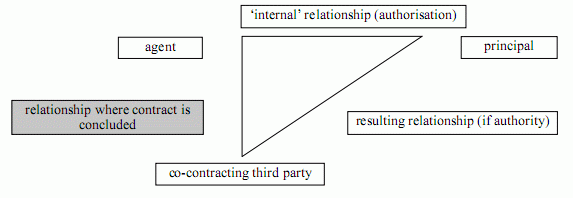
1.2. The form and features of this separation
The exact nature of the separation can be seen more clearly when one analyses the rules on the coming into existence of authority and its ending.
1.2.1. Coming into existence
The authority of a representative may be (a) granted by the principal (II.–6:103 (1)); (b) granted by the law (II.–6:103 (1)), this grant also being called authorisation; or based upon appearance: If a person causes a third party reasonably and in good faith to believe that he has authorised a representative to perform certain acts, the person is treated as a principal who has so authorised the apparent representative (II.–6:103 (3)). In the latter case, the authorisation is only ‘apparent’ but the authority is ‘real’: the agent has authority and not merely apparent authority. *6 The rule is an expression of the principle of reliance, which in the circumstances described receives priority over the pure autonomy principle.
The same applies for the scope or extent of the authority. The rules of II.–6:103 and IV.D.–1:102 (a) imply that directions given by the principal to the representative but not known to the third party do not limit the authority of the representative. *7
1.2.2. Ending of authority
The same separation between authorisation (in the internal relationship) and authority (in the external relationship) is found in the rules concerning the ending of the one and the other.
The rules on the ending of authorisation are found in the general rules of contract law, especially in Book III, supplemented by the specific rules on mandate contracts in Book IV.D., which provide that a mandate can, moreover, be revoked at any time by the principal (article IV.D–1:104), except in specific cases of irrevocability where revocation is restricted to the grounds of termination as in general contract law and some additional situations (see article IV.D.–1:105).
The rules on the ending of authority, on the other hand, are found in Book II — specifically, in II.–6:112. Again, the basic rule (paragraph 1) cites the apparent internal relationship as the criterion for the continuation or ending of the authority: “The authority of a representative continues in relation to a third party who knew of the authority notwithstanding the ending or restriction of the representative’s authorisation until the third party knows or can reasonably be expected to know of the ending or restriction.” *8 This also implies that authority does not end retrospectively.
The terms in paragraph 2 apply when the ‘third party’ is not really a third party; that is, “[w]here the principal is under an obligation to the third party not to end or restrict the representative’s authorisation, the authority of a representative continues notwithstanding an ending or restriction of the authorisation even if the third party knows of the ending or restriction”. This also means, a contrario, if there is no obligation toward the third party, authority is ended in the external relationship when the third party is notified or knows about the ending, even if the ending is not allowed in the internal relationship between principal and representative; whether the revocation is valid or not is for the third party a res inter alios acta.
1.3. Effect on the resulting relationship
The mechanism of representation in the DCFR implies, in conformity with the tradition, that the relationship between the principal and third party is the relationship as concluded between the representative and the third party. Both parties are in relation to each other as well bound by that relationship as able to invoke it.
Thus, the relevant elements for interpretation of the concluded contract are to be found in the acts and minds of the representative and the third party (not of the principal). However, as the principal is considered to be a party to the relationship from the beginning (and not only at a later stage, as in the case of acquisition by assignment for example), the mind and behaviour of the principal may be relevant for the application of certain rules relating to the formation and validity of the contract (e.g., bad faith of the principal). *9 It would lead us too far to discuss the details here.
2. New creditors
There are many situations wherein a person not being a party to a contract becomes a party to the contractual relationship. In this article, we analyse only the situations that can be seen as introducing a second creditor.
2.1. Stipulation in favour of the third party
A first example is the stipulation in favour of a third party. *10 I take it as the first example for consideration here because it bears some resemblance to representation, in that from the beginning it is intended that another party than the parties making the contract will become a creditor in the contractual relationship. In the stipulation in favour of a third party, there is no authority of the promisee/stipulating party to bind the third-party beneficiary, and neither is the stipulation made in the name of the third‑party beneficiary. But in other respects there is some analogy, even if the analogy is much closer to ‘indirect representation’ (see infra): the third party acquires a right against the promisor by virtue of a contract between the stipulator and the promisor. The analogy is obscured additionally because ‘third party’ and ‘internal relationship’ are traditionally used here in the opposite sense from that applied in the case of representation.
2.1.1. Rules on binding character and revocability in conformity with general contract law
It is interesting that the DCFR has, differing from many national legal systems, applied the general rules of contract law to these stipulations in favour of a third party in a coherent manner.
First of all, the creation of a right of the third-party beneficiary does not, as a matter of principle, depend on acceptance by the third party. According to article II.–9:302 (a), “in the absence of a provision to the contrary in the contract, the third party has the same rights […] as if the contracting party was bound to render the performance under a binding unilateral promise in favour of the third party”. It would indeed have been inconsistent to accept the binding force of unilateral promises (following from article DCFR II.–1:103 (2)) but not under the same conditions the binding character in relation to a beneficiary of a contract in favour of the beneficiary as long as the beneficiary has not accepted it. The beneficiary thus acquires the right or benefit as soon as the notice reaches the beneficiary (compare II.–1:106, ‘Notice’). Evidently, the parties may make the acceptance a precondition for the right of the beneficiary. And, where acceptance is not required, the beneficiary may, in conformity with general contract law, waive its right (see article II.–9: 303 (1), which states that “[t]he third party may reject the right or benefit by notice to either of the contracting parties”, the sole specific rule being that, upon such rejection without undue delay, the right or benefit is treated as never having accrued to the beneficiary).
Evidently, acceptance by the beneficiary (or authority of the stipulator to bind the beneficiary) is required where the beneficiary has to engage in some obligation itself. But in such a case, there simply is a normal contact with the beneficiary, although its rights and obligations can still be made dependent upon the fate of another contract, such as an underlying contract between the stipulator and the promisor.
Fully coherent with the basic approach, the revocability or irrevocability of the right or benefit of the beneficiary depends upon the terms of the basic contract (between the stipulator and the promisor); see article II.–9:301 (2) (“The nature of the third party’s right or benefit is determined by the contract”) and more explicitly article II.–9:303 (2) (“The contract determines whether and by whom and in what circumstances the right or benefit can be revoked or modified after that time”), as corrected by the reliance principle (in article II.–9:303 (3)). I understand this in such a way that, if desired, any intended revocability after the time the beneficiary was notified has to be stipulated.
2.1.2. Effects in the resulting relationship (promisor — beneficiary) and defences
As is expressed in article II.–9:301, paragraph II, the modalities of the resulting relationship — i.e., the obligation of the promisor toward the beneficiary — is fully dependent upon the contract and relationship between the stipulator and the promisor; otherwise, said obligation is not abstracted from it: “The nature and content of the third party’s right or benefit are determined by the contract and are subject to any conditions or other limitations under the contract.” *11 Article II.–9:302 repeats the same idea by providing the following:
(Where one of the contracting parties is bound to render a performance to the third party under the contract, then, in the absence of provision to the contrary in the contract):
(a) the third party has the same rights to performance and remedies for non‑performance as if the contracting party was bound to render the performance under a binding unilateral promise in favour of the third party; and
(b) the contracting party may assert against the third party all defences which the contracting party could assert against the other party to the contract. *12
On the other hand, the relationship between the stipulator and the beneficiary is in principle not relevant for the relationship between promisor and beneficiary (in the rest of this article, I will call the latter relationship the ‘valuta relationship’ and the former the ‘provision relationship’, following the terminology well known in the law on bills of exchange and generalised by doctrine in some national jurisdictions *13 ).
These rules are consistent with the general idea that the institution bears some analogy to an assignment of rights by the stipulator (the beneficiary can be compared to an assignee as new creditor) and not to an additional debtor of a possible obligation of the stipulator towards the beneficiary. This distinguishes the stipulatio alteri from a delegatio (solvendi).
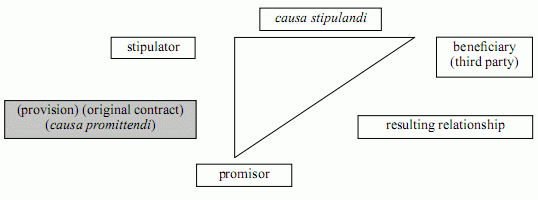
There are some differences from assignment, which can be explained when one keeps in mind that the right of the third-party beneficiary is not, as in assignment, transferred to the beneficiary at a later stage but is at the beginning created as a right of the beneficiary. Thus, there is no transfer of property in an existing right.
Given the idea that a stipulation in favour of a third party is in a sense halfway between representation and assignment, the questions arises of whether the beneficiary can in some circumstances have rights superior to what the stipulator has or would have (this question also arises in assignment). The DCFR deals only with the case of a revocable right where the beneficiary believes it to be irrevocable: where the parties have led the beneficiary to believe this and the third party has acted in reliance on this, it is protected (article II.–9:303, paragraph III). But the same should probably apply in regard to other elements of the obligation than revocability or irrevocability.
2.2. Assignment
In the DCFR, the assignment of a right to performance is first of all a transfer of property based upon the relationship between the assignor and the assignee: “An ‘assignment’ of a right is the transfer of the right from one person (the ‘assignor’) to another person (the ‘assignee’)”, according to article III.–5:102, paragraph I. This is a clear difference from representation and stipulation in favour of a third party, where no transfer of an existing asset takes place.
As a transfer of property, this would have been more logically a subject to be dealt with in Book VIII, on transfer of property, with regulation in Book III covering only the effect (or absence of effects) of this transfer in relation to the debitor cessus (the ‘internal relationship’). That is the approach taken in some of the most modern codes, such as the Dutch civil code of 1992. *14
I would have preferred the Dutch approach, which is more consistent with the rules themselves and would have clarified a pattern that is now a bit hidden in the rules and which can usefully be compared to the pattern of separation we have found in the case of representation.
2.2.1. Structure of the relationships
Where there is no abstraction of the transfer of property from the underlying relationship between assignor and assignee *15 , there is at the same time in several respects a separation between the property situation (the effect of a transfer from the assignor to the assignee based upon their underlying relationship) and the ‘internal’ obligational relationship with the debitor cessus. On the other hand, the resulting relationship between the assignee and the debtor is basically dependent upon the original relationship between assignor and assignee; in other words, it is not a new relationship but the original relationship wherein another creditor is substituted for the original creditor.
The main aspects of this separation and dependency are the following:
1. The transfer cannot give, in principle, the assignee a right with a different content *16 from the right the assignor had against the debtor. But it can give rise to a substitution of the creditor without the consent of the debtor. *17 There is neither a need for prior modification of the internal relationship (consent of the debtor) nor the effect of a modification of the internal relationship other than the substitution of the creditor. That substitution is the consequence of the transfer rather than a prerequisite.
2. There is an additional *18 element of separation in the rule of article III.–5:108, which provides that “[a] contractual prohibition of, or restriction on, the assignment of a right does not affect the assignability of the right” (i.e. does not prevent the transfer of property) (III.–5:108 (1)), but does on the other hand not deprive the debtor of:
(a) its right to perform in favour of the assignor and be discharged by so doing; and
(b) all rights of set-off against the assignor as if the right had not been assigned (III.–5:108 (2))”,
unless the debtor has consented or created reliance (III.–5:108 (4) (a and b)). *19
In other words, the property passes, but, in relation to the debtor, the creditor is only substituted for insofar as the debtor agrees or has caused reliance. That property passes also implies a priority for the assignee in relation to other creditors of the assignor (expressly in article III.–5:108 (3)). *20
On the other hand, the substitution of creditor in the internal relationship does not fully coincide with the transfer of property. By substitution of creditor, I mean the effect that the debtor can be discharged by paying to someone different from the original creditor and can no longer be discharged by paying the original creditor, and its counterpart that a different person can (in its own right) claim payment and the original creditor can no longer claim payment (in its own right). Apart from the situation mentioned supra where a right is assigned in breach of a contractual restriction, there are other situations of divergence between transfer of property and substitution of creditor. One has to distinguish between cases where this follows from property law itself (not related to the rules on assignment) and cases in which it follows from the rules of the law of obligations connected with the reliance principle and addressed in a more specific form in the rules concerned with assignment. The first type of case concerns the divergence between the ownership of the right and the authority to dispose of the right (also called entitlement to receive performance in III.−5:119 (5:118 in the interim version of the DCFR), which means entitled in the internal assignor/assignee relationship) (such entitlement may follow from rules of property law but also from a mandate for indirect representation). The second type of cases relates mainly to those addressed by article III.–5:119 (5:118 in the interim edition):
– on the one hand, according to paragraph 1, “the debtor is discharged by performing to the assignor so long as the debtor has not received a notice of assignment from either the assignor or the assignee and does not know that the assignor is no longer entitled to receive performance” *21 ;
– on the other hand, according to paragraphs 2 and 3 *22 , the debtor is discharged by performing in good faith to the person identified as the assignee in a notice of assignment from the assignor, c.q., if the creditor has caused the debtor reasonably and in good faith to believe that the right has been assigned to a person who identifies himself as assignee in a notice of assignment, to that person.
The debtor will also be protected if the assignment was void or retroactively avoided but this was not yet reported to the debtor at the time of performance.
In these cases, the same principle applies as in the case of an authority to represent based on appearance: performance to the apparent creditor discharges the debtor; the apparent creditor has authority to receive the performance, although he is not authorised (not entitled in accordance with his relationship with the owner of the right). The main criterion for this appearance is the notice given to the debtor.
As mentioned, I would have preferred to use here the same technique as applied with representation and mandate, where we dealt with both aspects in different places. However, in English, ‘assignment’ means both and is a well-established word, which made it difficult to convince the group to change this single term into two different words and speak, for example, of ‘transfer of property in the right’ on the one hand and ‘substitution of creditor’ on the other.
2.2.2. Effect in the resulting relationship and defences
1) Defences out of the provision relationship
In cases of assignment, the debtor has never promised anything to the assignee. Nevertheless, after assignment there will be a relationship between debtor and assignee of the same nature as the relationship that existed between debtor and assignor. If the assigned right is a contractual right, the contractual relationship continues to be of a contractual nature between the assignee and the debtor. It follows that this relationship is indeed dependent upon the original relationship (provision relationship); even more, it is the same relationship in which at some point in time the creditor is substituted.
The basic principle thus can only be that “[t]he debtor may invoke against the assignee all substantive and procedural defences to a claim based on the assigned right which the debtor could have invoked against the assignor” (article III.–5:116, paragraph I). *23 In principle, the defences of the debtor cannot be modified without the consent of the debtor.
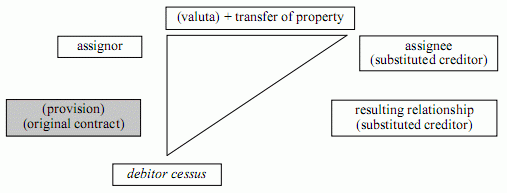
There are some exceptions to this rule, which are consequence of the general idea that rights are, in principle, transferable (expressed in III.–5:105):
– unless there is a valid contractual prohibition of assignment *24 , the debtor can be obliged — by being given sufficient notice *25 — to pay to a different creditor (ex III.–5:113);
– where the obligation is an obligation to pay money, the debtor can also be obliged to pay it in a different place within the European Union, under deduction of the costs incurred by reason of this change in the place of performance (article III.–5:117, paragraph I); and
– the debtor loses the possibility to invoke against the assignee a set-off with a right against the assignor that did not yet exist at the time of notice and is not closely connected with the assigned right (see article III.–5:117, paragraph 3). *26
Apart from these specific changes, the debtor retains all defences unless he has waived a defence or caused the assignee to believe there was no such defence (article III.–5:116 (2) (a)) (correction of the autonomy principle by the reliance principle, this time in favour of the assignor). *27
Finally, one has to take into account that, after assignment and the notification thereof, the relationship only exists between the debtor and the assignee, and all causes of extinction (not only payment) must relate to the assignee and no longer to the assignor in order for the debtor to be discharged (the set-off rule of article III.–5:117(3) proceeds from this idea).
2) Defences out of the valuta relationship
The internal relationship between the assignor and the assignee is, in principle, a res inter alios acta for the debtor. He cannot invoke defences that the assignor may have against the assignee (e.g., that the assignee has not yet paid the price), unless their effect is that there is no assignment or that it has already been retroactively avoided.
2.3. Appropriation of a right to performance by the principal in cases of indirect representation
The Principles of European Contract Law (PECL) contained some provisions on indirect representation (article 3:301 ff.), which were absent from the interim edition of the DCFR because they were still under discussion. In the final DCFR, the so-called direct action of the principal against the third party in cases of insolvency of the intermediary will be maintained, basically along the lines of article 3:302 PECL.
In that case, the principal has the right to take over the rights of the intermediary by notice to the third party. He will thus exercise against the third party the rights acquired on the principal’s behalf by the intermediary, subject to any defences that the third party may invoke against the intermediary. The DCFR rule will make the analogy with assignment clearer by providing that the third party has the same forms of protection against the principal as a debitor cessus against the assignee.
One can indeed see the exercise of the so-called direct action by the principal as a form of assignment based upon a unilateral act of the principal, which he is entitled by law to perform.
The position of the principal after such notice is thus in principle the same as the position of an assignee after provision of notice.
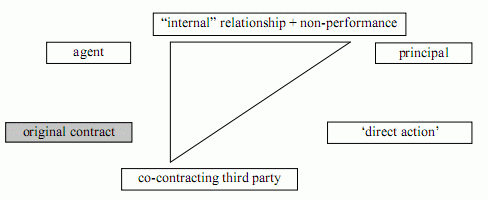
2.4. Subrogation
The rules on personal subrogation (or assignment ex lege) are still underdeveloped in the DCFR. On the one hand, only some of the possible cases of subrogation are explicitly mentioned. On the other hand, the consequences of subrogation are not fully explored. Nevertheless, it is possible to indicate the basic features of subrogation as they emerge from the rules found in the DCFR.
The DCFR does indeed spell out details of the most important cases of personal subrogation, in the chapter on plurality of debtors and in the book on personal security:
– According to article III.–4:107 (2), a solidary debtor who has performed more than that debtor’s share may, subject to any prior right and interest of the creditor, exercise the rights and actions of the creditor, including any supporting security rights, to recover the excess from any of the other debtors to the extent of each debtor’s unperformed share. Apart from this subrogation, the solidary debtor who has performed also has a right of recourse (article III.–4:107 (1)).
– According to article IV.G.–2:113, second sentence, the security provider *28 is subrogated, in so far as he has performed the secured obligation, to the creditor’s rights against the debtor. Here also, the right acquired by way of subrogation is concurrent with the right to reimbursement or recourse. Paragraph 2 also provides that in cases of partial performance the creditor’s remaining rights have priority over the rights to which the security provider has been subrogated.
– Article IV.G.–1:108 and IV.G.–1:109 contain rules on subrogation for the situation of a plurality of security providers.
– For the case of payment by a third party who is not also a solidary debtor, article III.–2:107 (2) mentions the possibility of subrogation — without spelling out, however, the requirements that may obtain.
As in the case of assignment, personal subrogation entails as well a transmission of property in a right as a change in the relationship with the debtor. The rules of the DCFR do not yet really distinguish these two elements or spell out the associated specific rules. In my opinion, this means that the rules on assignment must be applied with appropriate adaptations.
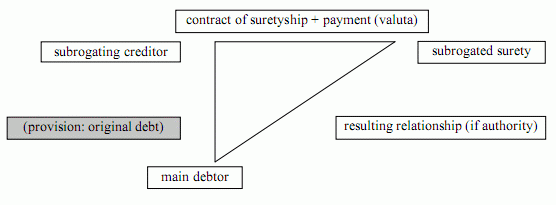
Thus, it is clear that the debtor against whom a right is exercised after subrogation may invoke against the subrogated party, in principle, all defences that he could have invoked against the original creditor, with similar exceptions. As for the relationship between the subrogating creditor and the subrogated creditor, the debtor can, in principle, only invoke it in order to limit the subrogation to the amount of performance by the subrogating party. Equally, the debtor should be discharged by performing for the subrogated creditor as long as he does not know that that person is no longer entitled to receive performance (compare article III.–5:119 (1) DCFR (formerly III.–5.118(1)).
2.5. Real subrogation
The rules on real subrogation are even more underdeveloped in the interim version of the DCFR. This is partly caused by the fact that this institution is mainly an institution of property law and should find its main place in the books on acquisition of property (Book VIII) and proprietary security (Book IX). Thus far, the provisional drafts do not, however, cover the main cases of real subrogation found in national legal systems.
There is one case of real subrogation described in Book III, in article III.–5:108 (3): where a right is assigned in breach of a contractual prohibition or restriction and the debtor performs in favour of the assignor (as he is entitled to do), the assignee’s claim against the assignor for the proceeds has priority over the right of a competing claimant so long as the proceeds are held by the assignor and are reasonably distinguishable from the other assets of the assignor. Although the term ‘real subrogation’ is not used, that is what this rule amounts to. The traditional requirements for real subrogation are spelled out: the assignee’s property in the right to performance is extinguished *29 but at the same time maintained because there is an identifiable ersatz object and there is a causal link between the loss of the original object of the property right and the presence of the ersatz.
On the other hand, there is no similar rule in article III.–4:206 for the event of a solidary creditor having received more than its share (it would be consistent to have similar priority here).
In the working group’s discussions of proprietary security, there were also clearly diverging opinions on the possibility for maintaining the priority of a transferor under reservation of title in assets replacing the transferred assets (e.g., the right to payment of the price when the buyer under reservation of title sells the unpaid-for goods to a third party).
2.6. Granting of a security interest in a right to performance
It will be interesting to see how the DCFR will deal with the situation in which a security interest is granted in a right to performance. Such granting can be seen as a negative element of assignment rather than something totally different: the acquirer acquires not ownership in the claim but a limited property right, a security right.
A series of associated matters can be seen to be basically the same as in the case of assignment: the requirements for the creation of the security right, the relationship between the creation of the right, and the relationship with the debitor cessus.
There is one important difference: the limited character of the security right implies first of all in the system chosen by the DCFR that the security right is accessory or dependent upon the creditor’s right to performance. For the matter of the defences, this must have the concomitant effect that the debtor cannot only invoke all defences from the relationship with its creditor (the security-giver); it also has to invoke all defences the main debtor (the security-giver) has against its secured creditor. In other words, the exercise of the security right is “subject to any defences which the security giver may set up against the secured creditor and those which the debtor of the encumbered right may set up against the security giver”, to paraphrase PECL article 3:303.
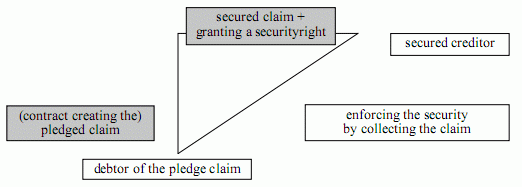
The latter rule is the PECL rule on the actio contraria of the third party against the principal of his contractor in cases of indirect representation. That rule will only in a minor form be maintained in the DCFR. But the rule on defences shows that the nature of such an actio contraria is that of a security right in a claim.
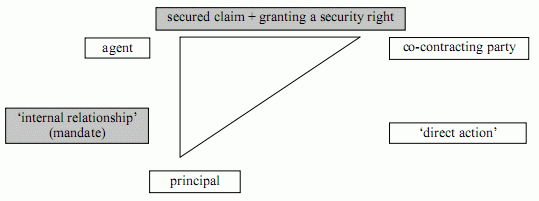
2.7. New creditors – conclusion
The analysis I have undertaken is an attempt to show that there is a sufficient degree of coherence in the rules concerning different multiparty situations that have in common their addition or substitution of a creditor to a relationship, in one way or another. Certainly, the coherence could be made even clearer, but one cannot expect too much — the result thus far is already rather innovative in this domain.
3. New debtors
A similar analysis could be conducted of the rules concerning different multiparty situations that can be seen as the addition or substitution of a debtor: the substitution of debtor in the strict sense (article III.–5:201) and transfer of contractual position (III.−5:301), the additional debtor (rules not yet present in the interim edition but to be included in the final DCFR), the dependent personal security (IV.G., section 2), the different forms of delegatio solvendi (not regulated as such in the DCFR) and its specific forms such as the independent personal security (IV.G, section 3), money transfer and the different payment instruments, etc. In these situations, too, it is very helpful to analyse the different relationships separately, taking into account for each to what extent each relationship is dependent upon or independent from one or more of the other relationships. I hope to do this in another article, but by way of example I shall draft the triangle for dependent personal security.
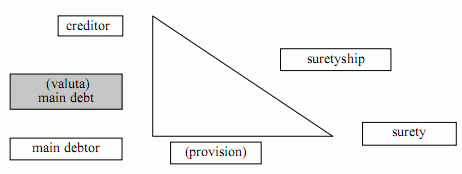
pp.78-88


